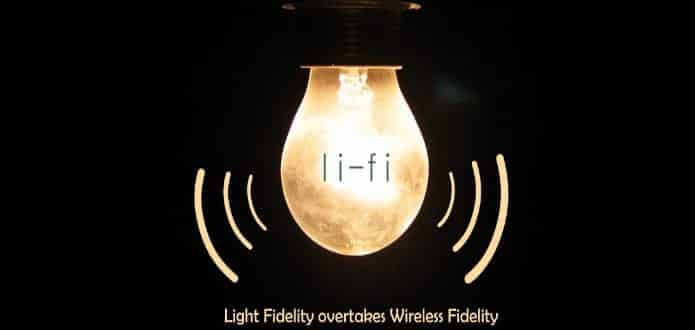Li-Fi uses light bulbs to deliver speeds 100x faster than Wi-Fi
Move over Wi-Fi. Welcome Li-Fi, a super-fast alternative to WiFi. Moving beyond the research lab, Li-Fi has entered into a real-world test and is expected to change everything about the way we use the Internet.
Li-Fi is a wireless technology that transmits high-speed data using Visible Light Communication (VLC). Earlier this year, the lab testing saw scientists achieve speeds of 224 gigabits per second in the lab using Li-Fi.
Estonian startup Velmenni has begun to offer the Li-Fi technology in a commercial setting. The company is using LiFi to send data at up to 1Gbps – more than 100x faster than current WiFi technologies. To put this in real-world terms, you could expect to download a high-definition film in just a few seconds.
“We are doing a few pilot projects within different industries where we can utilise the VLC (visible light communication) technology,” Deepak Solanki, CEO of Estonian tech company, Velmenni, told IBTimes UK.
“Currently we have designed a smart lighting solution for an industrial environment where the data communication is done through light. We are also doing a pilot project with a private client where we are setting up a Li-Fi network to access the Internet in their office space.”
Back in 2011, Li-Fi was invented by Harald Haas, a professor of mobile communications at the University of Edinburgh in Scotland, who for the first time had illustrated that he could transmit far more data by flickering the light from a single LED. According to Haas’s research, Li-Fi can achieve data density 1,000 times greater than Wi-Fi, because Li-Fi signals are contained in a small area, as opposed to the more diffuse radio signals.
The technology uses VLC, a medium that uses visible light between 400 and 800 terahertz (THz). Basically, it works like this – flicking of an LED on and off at extreme speeds that are imperceptible to the naked eye can be used to write and transmit things in binary code.
The main benefit of Li-Fi over Wi-Fi, is the increased privacy and security which it offers. Data is sent at high-speeds using VLC cannot pass through walls and is therefore, less at risk from being intercepted as well as from suffering with interference from other devices.
Li-Fi will most likely not completely replace Wi-Fi in the coming decades pointed Anthony Cuthbertson to IBTimes UK, but the two technologies could together be used to attain more safe and efficient networks.
Using light bulbs around the home or workplace, Li-Fi could deliver high-speed data transmission for internet access or IoT (Internet of Things) deployments. The biggest challenge for Velmenni, and others looking to harness Li-Fi technology, is finding ways to retrofit existing devices with the new technology in order to prevent having to create a whole new infrastructure.
Research teams around the world are working on just that. Haas and his team have launched PureLiFi, a company that offers a plug-and-play application for secure wireless Internet access with a capacity of 11.5 MB per second, which is comparable to first generation Wi-Fi. Haas also sees Li-Fi as a way to bring internet to remote locations, using hilltop transmitters and rooftop solar panels. LED streetlights could even be used to form a network of outdoor Li-Fi, making it possible to stay connected when walking around the city.
Further, French tech company Oledcomm is in the process of installing its own Li-Fi technology in local hospitals. Also, Chinese researchers have developed a basic Li-Fi prototype as well, powering several laptops with one LED bulb. The Fraunhofer Institute, a German research organization, has been working on Li-Fi hotspot prototypes as well. Even NASA recently announced plans to study Li-Fi’s potential uses in space travel.
If applications like these and the Velmenni trial in Estonia prove successful, we could achieve the dream outlined by Haas in his 2011 TED talk below – everyone gaining access to the Internet via LED light bulbs in their home.
“All we need to do is fit a small microchip to every potential illumination device and this would then combine two basic functionalities: illumination and wireless data transmission,” Haas said. “In the future we will not only have 14 billion light bulbs, we may have 14 billion Li-Fis deployed worldwide for a cleaner, greener, and even brighter future.”
“The incandescent lightbulb delivers illumination,” Haas says. “In 20 years, the [LED] lightbulb will deliver hundreds of applications”.
